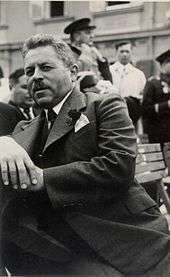Marko Natlačen
Marko Natlačen (24 April 1886 – 13 October 1942) was a Slovenian politician and jurist, who also served as the last ban (governor) of the Drava Banovina in the Kingdom of Yugoslavia. He played His assassination at the hands of the Slovenian Communist secret police (VOS) during World War II was an important event in the escalation of the armed conflict between the Slovenian partisans and the Slovenian anti-revolutionary forces in the Province of Ljubljana. The role of Natlačen during World War II and the extent to which he collaborated with the Fascist Italian forces has been disputed.[1]

Biography
Natlačen was born in the village of Manče in the upper Vipava Valley, in what was then the Duchy of Carniola within the Austro-Hungarian Empire.
Natlačen finished his law studies in Vienna and then moved to Ljubljana, where he worked in a law firm. He was a member of the Slovene People's Party and an anticommunist. During the Second World War he founded the National Council of Slovenia (Slovene: Narodni svet za Slovenijo) together with the leaders of other political parties.[2] On May 4, 1941, the day after the Italians annexed the Province of Ljubljana to Italy, Natlačen and a number of other Slovene politicians wrote a letter to Mussolini, congratulating him on the act.[3]

He initially accepted a position on the Italian-establish advisory council for the Province of Ljubljana, and on June 8 led a delegation to meet with Mussolini in Rome, after which he wrote Mussolini another letter expressing "complete loyalty".[4] But he resigned later that year since he saw the Italians were not interested even in any advice from the council and his opposition to the Italian authorities and their unlawful treatment of people in the Province of Ljubljana. Together with the Albert Kramer of the Liberal Party, he helped draft the London Points (Slovene: Londonske točke) on October 1941, which stated that the goals of Slovene prewar parties was the renewal of the Kingdom of Yugoslavia, and designed that Chetnik army of Draža Mihailović as the only legal force, while all others, including the Partisans, were declared treasonous[5]
In 1942 Natlačen played a key role in establishing the MVAC, a Slovene collaborationist militia that fought under the command of the Italian forces, having written in May 1942 a memorandum to the Italians suggesting the creation of such units. Natlačen was still the internal leader of the Slovene People's Party, when the party's army, the Slovene Legion, joined the Italian MVAC forces, to jointly fight against the Partisans
He was assassinated by the communist secret police (VOS, Security and Intelligence Service) at the order of the Communist Party of Slovenia.[2] Reflecting his importance to the collaborationist cause, the Fascist authorities in retaliation for Natlačen shot 24 Slovene hostages, suspected supporters of the Liberation Front.[6] After the war the communist authorities desecrated his grave, exhumed his remains, and disposed of them at an unknown location.[2]
Controversies
Natlačen published the anti-Serb xenophobic poem Srbe na vrbe (Hang the Serbs on the Willow Trees) in the Ljubljana newspaper Slovenec on 27 July 1914, the day before Austria-Hungary declared war against the Kingdom of Serbia.[7][8][9]
References
- "Spomenika Marku Natlačnu ne bo" [There Will Be No Monument to Marko Natlačen]. Delo.si. 10 October 2007. ISSN 1854-6544.
- Sirc, Ljubo. 1992. Med Hitlerjem in Titom. Ljubljana: Državna založba Slovenije, p. 14–15.
- Kranjc, Gregor Joseph (2013-01-01). To Walk with the Devil: Slovene Collaboration and Axis Occupation, 1941-1945. University of Toronto Press. p. 93. ISBN 978-1-4426-1330-0.
- Kranjc, Gregor Joseph (2013-01-01). To Walk with the Devil: Slovene Collaboration and Axis Occupation, 1941-1945. University of Toronto Press. p. 63. ISBN 978-1-4426-1330-0.
- Rant, Jože. 2008. Slovenski eksodus leta 1945. Buenos Aires: M. Loboda, p. 57.
- Tomasevich, Jozo (October 2002). War and Revolution in Yugoslavia, 1941-1945: Occupation and Collaboration. Stanford University Press. p. 98. ISBN 978-0-8047-7924-1.
- Gestrin, Ferdo, & Vasilij Melik. 1950. Slovenska zgodovina, 1813–1914. Ljubljana: Državna založba Slovenije, p. 165.
- Saje, Franček. 1952. Ljubljana v ilegali: V odločilnih dneh, vol. 1. Ljubljana: Slovenski knjižni zavod, p. 10.
- Slovene History – 20th Century, Selected Articles Written by Dr. Božo Repe, p. 116 Archived 2011-06-08 at the Wayback Machine